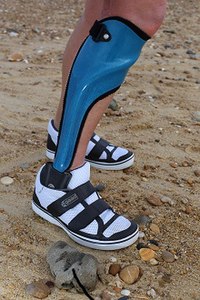
Photo from wikipedia
Foot strike patterns influence the running efficiency and may be an injury risk. However, differences in the leg stiffness between runners with habitual forefoot (hFFS) and habitual rearfoot (hRFS) strike… Click to show full abstract
Foot strike patterns influence the running efficiency and may be an injury risk. However, differences in the leg stiffness between runners with habitual forefoot (hFFS) and habitual rearfoot (hRFS) strike patterns remain unclear. This study aimed at determining the differences in the stiffness, associated loading rate, and kinematic performance between runners with hFFS and hRFS during running. Kinematic and kinetic data were collected amongst 39 runners with hFFS and 39 runners with hRFS running at speed of 3.3 m/s, leg stiffness (Kleg), and vertical stiffness (Kvert), and impact loads were calculated. Results found that runners with hFFS had greater Kleg (P = 0.010, Cohen′s d = 0.60), greater peak vertical ground reaction force (vGRF) (P = 0.040, Cohen′s d = 0.47), shorter contact time(tc) (P < 0.001, Cohen′s d = 0.85), and smaller maximum leg compression (ΔL ) (P = 0.002, Cohen′s d = 0.72) compared with their hRFS counterparts. Runners with hFFS had lower impact peak (IP) (P < 0.001, Cohen′s d = 1.65), vertical average loading rate (VALR) (P < 0.001, Cohen′s d = 1.20), and vertical instantaneous loading rate (VILR) (P < 0.001, Cohen′s d = 1.14) compared with runners with hRFS. Runners with hFFS landed with a plantar flexed ankle, whereas runners with hRFS landed with a dorsiflexed ankle (P < 0.001, Cohen′s d = 3.35). Runners with hFFS also exhibited more flexed hip (P = 0.020, Cohen′s d = 0.61) and knee (P < 0.001, Cohen′s d = 1.15) than runners with hRFS at initial contact. These results might indicate that runners with hFFS were associated with better running economy through the transmission of elastic energy.
Journal Title: Applied Bionics and Biomechanics
Year Published: 2020
Link to full text (if available)
Share on Social Media: Sign Up to like & get
recommendations!